This collection is out now for Imbolc. Lots of good stuff. I have a few poems therein.
Happy Imbolc!

This collection is out now for Imbolc. Lots of good stuff. I have a few poems therein.
Happy Imbolc!
In the spring I was diagnosed with cancer. This fall I went through two and half months of radiation ‘therapy’ and am presently recovering from the side effects of the treatment, which include much fatigue.
I had planned to post considerably more about my trip to Ireland, but haven’t had the focus for it. Going to Kildare was a pilgrimage and a journey for healing; I think I got quite a boost there.
Visiting the wells, praying at both the new and old ones, tying clooties and visiting Solas Bhríde, the ecumenical spiritual center established by the Brigidine Sisters were tremendously rewarding. The center was a real highlight with the chance to pray in front of the flame maintained since 1993, the wonderful hospitality and stories of Sister Phil, the walk in the labyrinth and meditation in the willow bothy, and just walking in beautiful grounds that include a rewilding area, full of the radiance of Brigid, Goddess and Saint.
The whole town seemed permeated with the Lady, from the market square in the center of town with its tall acorn lantern (where Mary Robinson, the president of Ireland lit the flame in the 90s), to the functioning Catholic parish church with its acorn sculptures outside. The famous medieval cathedral could only be viewed from outside and the grounds were still closed because of the pandemic (the helpful folks at the Visitor Center thought they were being silly to not open the outdoor area, oh well), so we couldn’t see the fire temple but so much else was experienced.
So here are photos of Kildare, Brigid’s town.




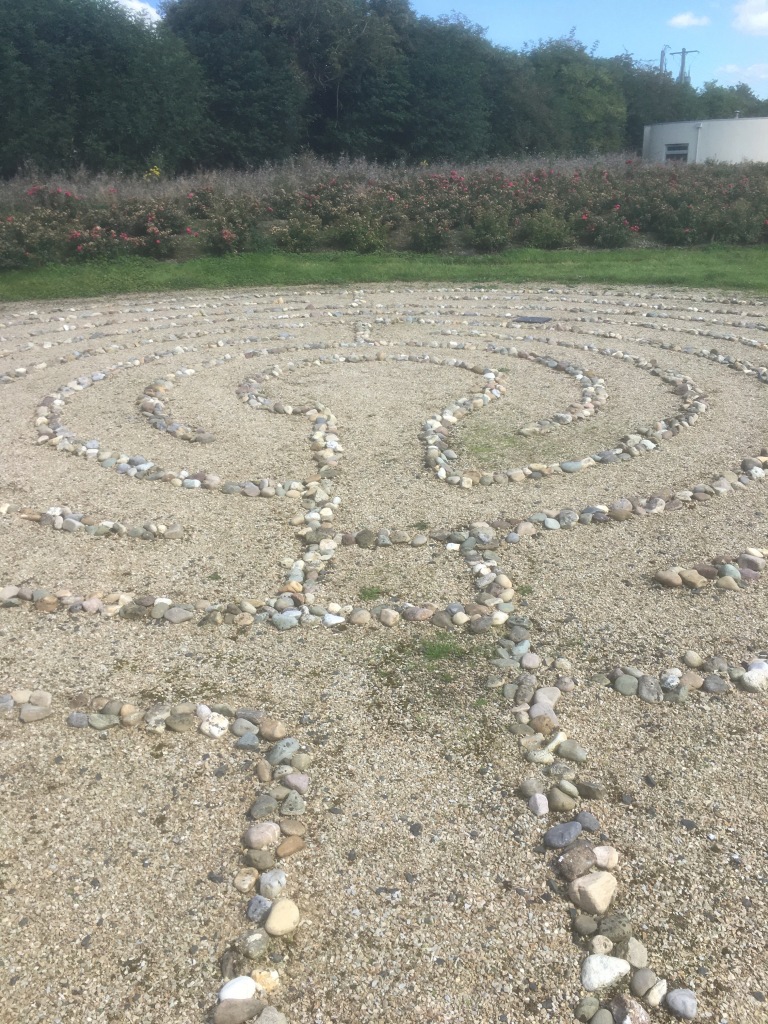




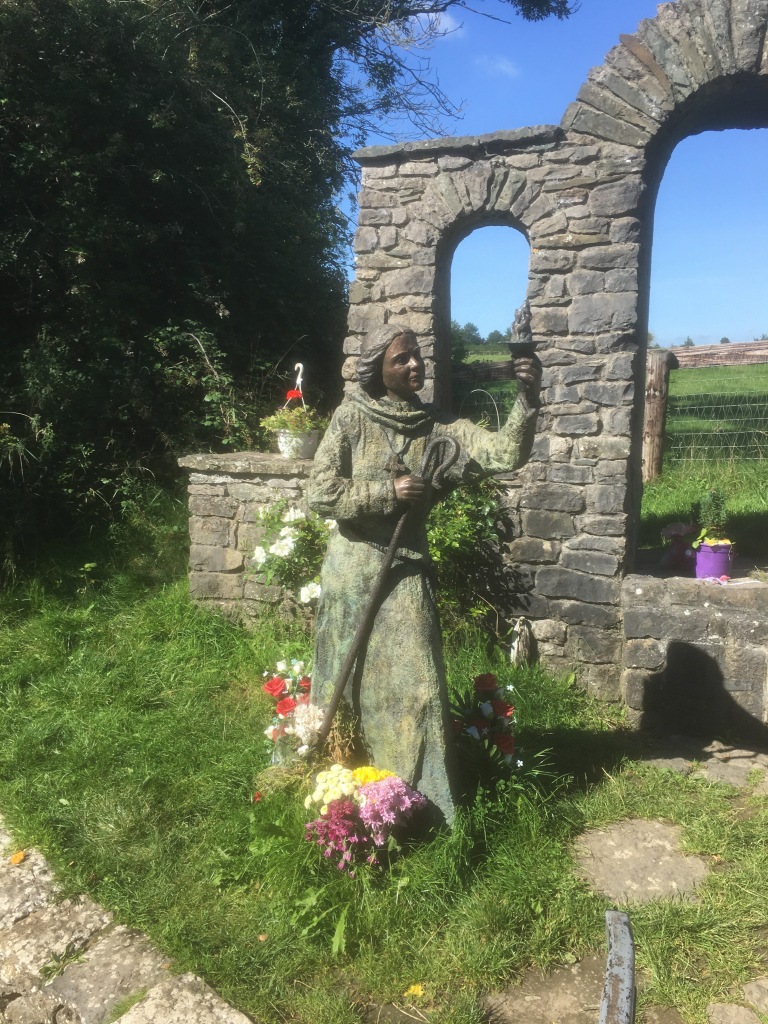
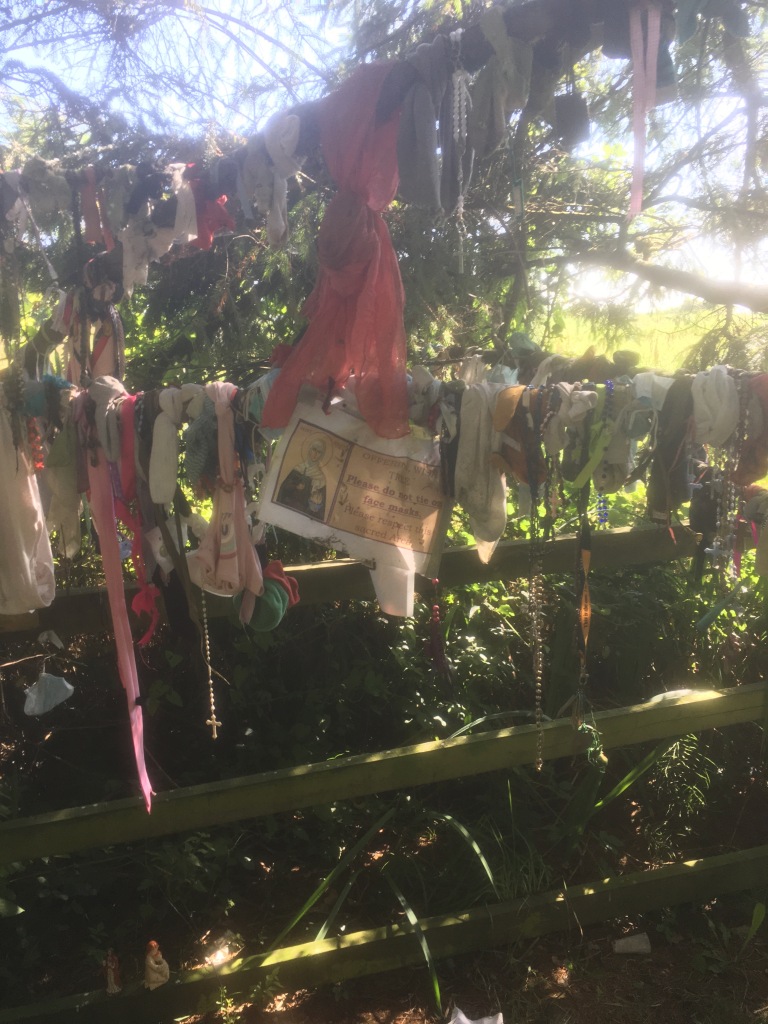

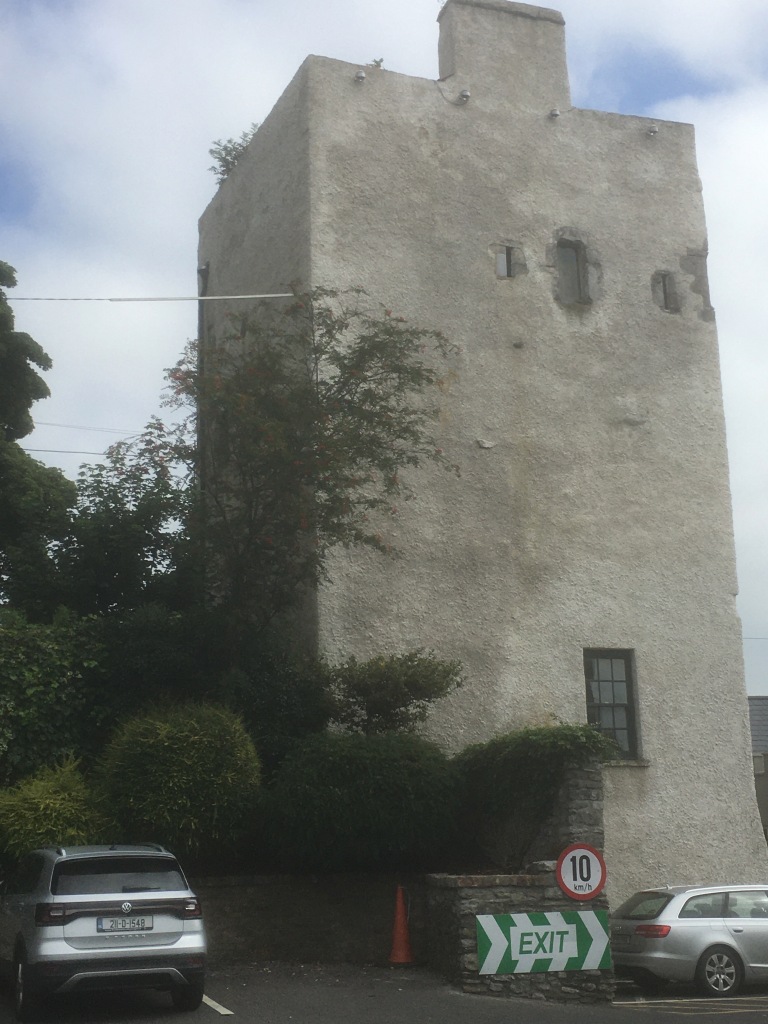
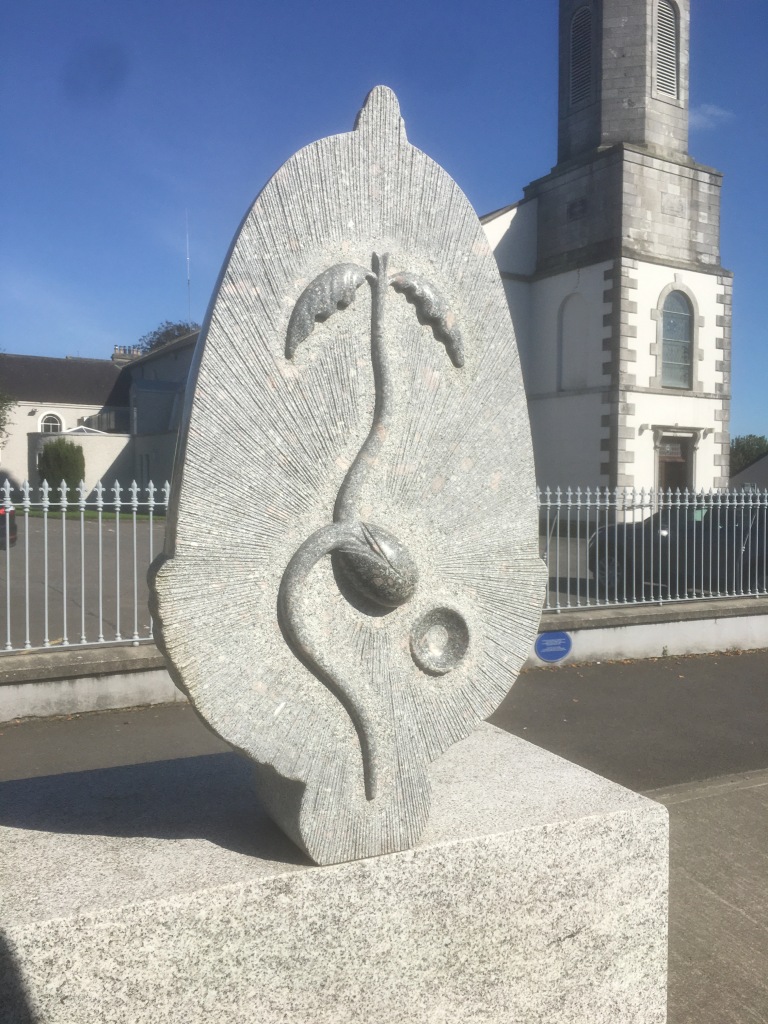
I’ve recently returned from a richly inspiring trip to Ireland and will be posting pictures and thoughts. Here’s the first.
Through a screen of leaves—ash and hazel and alder and others, including berries whose name I don’t know—I peer out at Brúgh na Bóinne.
The waters flow along in this river that transcends time, taking us back millennia to when early farmers first settled here and raised huge passage tombs and mounds and woodhenges. The leaves whisper of even earlier peoples, the hunter-gatherer-fishers of the Mesolithic who found rich forage here when the valley was all forested. As I gaze the waters meander onward toward the sea past the nearby town of Drogheda where we are staying. Into an uncertain future.
In the lore Waters take us into the liminal. By the water is a place of revelation, of eicse, which can mean inspiration, divination or the art and science of poetry. As Nede demonstrates in the beginning of The Colloquy of the Two Sages (Immacallam in dá Thúarad) when he goes to the shore and learns of his father’s death from the waves.
The sound of the waters do their liminal work—there seems to be a rapid just upstream, I think it’s probably a weir. A feminine voice gives a healing message in this spot of healing plants and ancient spirits. Is this Bóinn (or Boann), her waters ever flowing? She is the Boyne, right? Maybe she is a deep ancestor of this land, of this river valley, but one who flows in the sky too.
The presence of Nechtan also resounds, the waters mythologically flow from his well far upstream near the present day village of Carbury. Of course this was the well where his wife Bóinn transgressed walking tuathal, against the sun, violating the taboo of its only being able to be approached by her husband and his cupbearers. Bóinn, the river itself, and the river in the sky, the Milky Way. The lore tells us in this creation of the river, she was carried out to sea with her small lapdog, named Dabilla. Dabilla was turned into a rock off the coast, the small islets known today as Rockabill.
Below is a mythologically interesting (if not aesthetically) painting in the Millmount museum in Drogheda.
Was Bóinn already a goddess (presumably with a different name) long before the Celts when the great monuments were raised here? For a very insightful take on this and Bóinn in general there is Anthony Murphy’s (he of Mythical Ireland) book Bóinn: the Goddess of the River Boyne and the Milky Way. https://mythicalireland.com/purchase/mythical-ireland-monograph-no2-binn-goddess-of-the-boyne-and-milky-way/
He states, “The intent of this monograph is to present a comprehensive portrayal of Bóinn from all the manuscript sources about her, and to depict her as a deity in her own right who has immense significance to the early mythological history of the Boyne valley.” I think he succeeds—a recommended read.
The waters flow on, a beautiful music, flowing for millennia with its salmon and trout hopefully far into the future.
The recent disclosure of vast amounts of (25,000 or so) barrels of leaking DDT filled barrels in the deep waters off the southern California coast, was, well, disturbing to say the least. During my childhood my family often spent summer weekends at Santa Catalina island with its seemingly pristine reefs and kelp forests. The toxic barrels were secretively dumped in those far off years and recently discovered.
This poem is a response.
Emerald Cove
We swam, diving in lucid waters
among the kelp forest on the reef
stared at by red saddled sheephead *
fish who munched on sea urchins and
lit by the golden globes of garibaldi**.
Innocence unaware that
eight miles offshore of the island
barrels of DDT sludge were being
dumped in the thousands upon thousands
on the continental shelf
in the murk, the barrels slowly
leached all these years dichlorodi-
phenyltrichloroethane.
We knew the pelicans with their
great beaks and fishing prowess
had disappeared unable to hatch
their eggs without breaking them,
and the eagles were long gone.
That we knew but not the sinister
presence in 3000 feet of water,
lurking to this day now revealed
in the deep, half a century
after the chemical’s banning
in the US though its maker
Montrose continued for years
exporting to other lands.
The ocean was infinite in those
mid-century years: dump anything into it
and forever gone except
in the monster movies where
the deep would erupt but that
was mostly left to Japan.
Sinister the tens of thousands of barrels
waiting all these years, waiting, waiting
leaking and corroding in the pressures
of the deep ocean, waiting, your truths
now revealed to the cameras.
emerald cove your water so clear
the abalone and the lobsters
on the rocks the sculpin and bass
swimming among the fronds—
experience held in memory,
caught in the traps of loss.

**A species of orange damselfish, Hipsypops rubicundus, sometimes called California goldfish.
Strange Beauty: Ecocritical Approaches to Early Medieval Landscape by Alfred K. Siewers
There are several intriguing arguments made in this book that made it a worthwhile read, though I am not a Celtic Christian. It is a very dense read, though, and at times a bit of a slog through untrimmed thickets of academic jargon. Strange Beauty is part of a series called The New Middle Ages from Palgrave MacMillan*.
I found Siewers’ geographic and cultural focus on an Irish Sea region interesting, the including of Ireland and western Britain together, and his gathering Irish and Welsh literature through this lens insightful. He uses the term Irish Sea region for Ireland and Wales as a key geographical and cultural zone and also centers ‘archipelagic’ as a key concept. In his view archipelago and otherworld reflect each other in a rich and ever productive way. Siewer’s understanding of the otherworld is as something continuous, multi-form and expressing deeper or normally hidden levels of our daily realities. This would be in contrast to views like that of Patrick Sims Williams who argues for the multiple nature of plural Otherworlds in “Some Celtic Otherworld Terms”.
Siewers is a Christian and he reads the stories he analyzes as always having strong Christian components (anti-nativist, at times annoyingly so to this reader). What I found fascinating with his portrayals of currents of Christianity that would eventually lose out in the later middle ages but that were positive toward this-world as Creation. Perhaps the most interesting chapter was the one on Eriugena, titled “Paradise in the Sea: An Early Geography of Desire” with an extensive analysis of the Periphyseon (De Diusione Naturae) of the 9th century Hiberno-Latin philosopher and theologian. He sees John Scotus Eriugena as celebrating a cosmic participation and of nature being permeated with theophanies of the Creator. Eriugena comes across as a fascinating thinker and theologian of a constrained time and of great interest to pantheists and Christians of a ‘creation spirituality’ emphasis, I would think (but also for this pagan reader). He asserts, somewhat disingenuously I think, that Eriugena was not a Neoplatonist, he sure sounds like this was a major influence on him via the early Christian Neoplatonists and it’s stated his being influenced Pseudo-Dionysius (a 5th/6th century Neoplatonist).
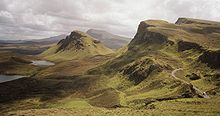
There is an interesting chapter on the colors of the winds where the creates an interesting color wheel with some insightful thoughts on glas (blue-green-gray). He compares its usage to the color of gold used in byzantine icons in which the viewer loses a sense of where background ends and figure begins. Siewers writes that in Dionysian/Eriugenean theology imagined divine energies “in nature as a relational experience entwined language and color”. Glas as color melds sea and sky.
A chapter called the “Cosmic Imaginarium” has some interesting perspectives on topography and both textual and visual style found in early Irish contexts which he calls ‘inverse perspective’, analyzing the Tain. Truth is searched for via multiple perspectives, and multiplex images are exteriorized between the art and the reader (he calls this exteriorized dialogic and notes its use in Byzantine icons). The narrative style through using variations deflects interiorization of the reader into the image, as does the content of the stylized dual nature of the landscape—otherworldly and thisworldly, implicitly Christian and explicitly pagan—“all related to actual topography. Theories of perception expressed in such effects were taken seriously as life practices in that era.” These become mysteries not be ‘penetrated’ as in modern landscape but to be engaged with. Even Cuchullain’s warp spasms are interpreted in this multi-perspectival way, a fluidity of body, which he also sees in the figures in the Book of Kells. Compared to the Coptic and Byzantine works of the time the Irish has the archipelagic emphasis on landscape and engagement with nature, the immersiveness of sea and sky.
The last chapter “Archipelago and Empire” contains insightful material on the different takes between the Celtic archipelagic landscape orientation and the Anglo-Saxon and Frankish one which took on the dominant role in western Christianity. The ‘Archipelagic’ form was one of multiple temporalities intersecting, of the divine penetrating nature and in the fluidity of the Otherworld whereas in the imperial, ecclesiastical one the Other anchored a firmly delineated individual (male) upon a landscape. He gives Beowulf as an example in his dive into the swamp where he slays Grendel’s Mother; Siewers sees this in terms of the psychological theory of Julia Kristeva, where in the dominant western paradigm identity is formed by opposition to the Other (my thoughts were a very significant change had occurred from the era when the numen of the mere would have received gifts or sacrifice instead of being visualized as slaughtered). “Bede’s temporality would come to be figured dominant. But the landscape of the Mabinogi, and those of the early Irish Sea zone generally, remain obscured yet still activated tropes of iconographic resistance to the Western tendency to reform nature into interiorized virtual reality.” This triumphal attitude he then relates to colonialism and empire. Siewers finds the tradition of participatory relationship and interpenetration with the other to be a rich resource for ecological relations now. There is so much more in this packed book from which I learned a lot, including about earth-friendly currents of early Christianity that were historically overwhelmed. A worthwhile read for those who want to know more about the early Christian era of Ireland and western Britain, the era when the literature was shaped.
*These are very over-priced books but can be purchased once a year in the huge Palgrave sale (or obtained via InterLibraryLoan).
There are a lot of words pouring out about the attempted coup yesterday in the US Capitol, which focus on the ‘Q Shaman’, a man from Arizona whose image is quite a concoction of appropriated Native American (Plains) bull horn headdress, the Norse Valknut and Thor’s Hammer tattoos, makeup of the US flag on his face, and another tattoo of a tree, which some sources have said is Yggdrassil, Norse tree of life.
For instance here: https://wildhunt.org/2021/01/heathens-respond-to-q-shaman-and-norse-imagery-in-capitol-riot.html
But it looks very much like the Celtic Tree image of the lovely Welsh artist, Jen Delyth to me, a representation of the bile, the sacred tree under which Irish chieftains were once inaugurated. I once had a t-shirt similar to this, which I wore to pieces:

I show this to emphasize that it is not only Norse pagans that have this problem. Celtic spiritualties are being appropriated and associated with the rampant white supremacist move in the US. This is also a problem with Druidism, Celtic paganisms/polytheisms in general. We need to be vigilant about these appropriations (and of course the people doing it).
The Q Shaman apparently had a mashup of beliefs, Christian, Odinist, Native American, etc. Stirred into a toxic brew of white nationalism and Q-anon conspiracy theory.
These are very frightening times in this country. I hope readers are well and safe.
Continue reading “Appropriation of Celtic Symbols by Racists”I wanted to share a book of spiritual offerings of awen that I have enjoyed so much, dipping into its pages over and over again in the past few depressing months for nourishment: The Deep Music: Offerings for the Awen. It is edited by Lorna Smithers, Greg Hill, and Lia Hunter and came out early this year, published by Awen ac Awenydd.
In the 12th century Geraldus Cambrensis, Gerald of Wales, wrote of the awenyddion, the inspired and visionary poets of Wales; these poets have many parallels with the filid of Ireland. Smithers relates a letter by Henry Vaughan from 1694 about a young man who fell asleep and dreamed of a beautiful, garlanded young man with a hawk on his fist. The hawk flew into the dreamer’s mouth, bringing the gift of poetry, which “they called awen.” The shepherd became the most famous bard of his time. She speculates that this vision was Mabon, who breathed in the gift of poetry. This is a lot like how the Muses breathed poetry into young Hesiod in Greece, when he too was a young shepherd.
The offerings are wide and deep, with many surprises.
Greg Hill writes in “The Way of the Awenydd” that “the ways to Faery are twisted into the weave of the landscape and are revealed through close relationship with particular places and the natural world.” If we take this path it “leads to the Nemeton, or sacred grove, where portals to the Otherworld may open and inspiration fill the seeker with knowledge for which it is difficult to find words, though seeking for the words that form as patterns of significance is also a path of discovery for an awenydd.” I’d say it may be difficult but that is our challenge.
Lorna Smithers tells of being taught to “walk the Star-Strewn Pathway” by her patron Gwyn ap Nudd. It can be walked in humble surrounds among backyards of earthworms and spiders in the compost as well as in ancient woodlands with the oak men. She visits the Fairy King’s hall but also reminds us that “Apostasies need voicing in cafes and bars, chain-stores and museums.”
Cat Heath in “Chasing Deer” shares an amazing personal initiatic journey full of encounters with the dead extending over several periods of time that brings her to Gwyn the psychopomp.
Kevin Manwaring shares an astounding encounter in a burial mound when hiking the Highland Trail in Scotland, as an arrogant youth (his description), he received the Green Music from the Lady who dwelt within; the kind of gift that require much in kind. “The price of the Green Music was my very soul.” If you are not familiar with him he has written numerous worthy books and won the Bardic Chair of Caer Badon (Bath) back in ’98.
Sithearan NicLeòid offers the “Wisdom of Fire and Water: A Pan-Celtic Awenydd Path” where she writes of her exploration of her Scottish, Irish, and Welsh heritage through music, scholarly study, and learning the languages. Her Pan-Celtic approach feels very refreshing in this time where the trend is too narrowly focus on modern national groups, partially, I think, due to the tsunami of social media identity politics. There are so many parallels between the Irish and Brythonic traditions, and as a person of Irish but also Welsh heritage this really resonates with me. She shares some remarkable encounters in the Scottish Highlands and along the Boyne river and at Emain Macha.
And there’s the wild ride Rhyd Wildermuth takes the reader on in “Awakening the Land” with encounters with giants, the mercurial Taliesin (“a mad liar, an awen-drunk poet slipping in and out of time and place to become everything, ..He doesn’t stay well in time”, Brân, Afaggdu (the Utter Dark) who he says ‘might be a beard-flaying bear), Arthur, Cerridwen, etc. Rhyd claims “to learn about a god, you must go mad.” Some prescient thoughts on the disenchanted world of contemporary tech, noting the kind of results you get putting the names of gods into a search engine and looking for the existence of Apollo give you info about moon-landing conspiracies. “But that’s what we think we’re left with, which his at least part of the reason why the world’s disenchanted, the collective symptom of our shared disease, the ones that’s infected both this world and Others, the ones where They live, the ones where it makes sense to plant legumes to a climb a world-vine to meet a giant or to hang a hundred feet above the ground to talk to one.” Makes me think about the poisonous (capitalist) pedagogies that we were disciplined with as children to accept the world of disenchantment. Lots of little gems scattered throughout like that of Brân being the original Fisher King of Arthurian romance.
Hilaire Wood in “As When the Mystic: Inspired Poetry and the Path of the Awenydd” reminds us that “Poetry is potentised language and even in our secular society it takes its rightful place at ceremonies of birth, marriage and death, the rites of passage.” And that the poem is its own entity with a life of its own as her experience with Keat’s “Ode to a Nightingale” showed her.
There is so much more here including poems by Catriona McDonald, Angharad Lois, Brian Hewitt, Charlotte Hussey, Hazel Loveridge, Aurora J. Stone, and Lia Hunter.
My only criticism is that it would have been good if received another round of proofreading (the 2nd Battle of Tadhg Mor was a real blooper, I hear).
You can get a copy of the book here:

On Sept 29th I celebrated Gwyn ap Nudd’s Feast for the first time. I offered apples. I didn’t have access to mead so offered another libation. Thanks to Lorna Smithers to orienting me to this celebration. /https://lornasmithers.wordpress.com/2020/09/26/gwyns-feast-2020/
I was inspired to write this poem afterward.
On Gwyn’s Feast
Cloaked in moonlight
the damp of cold earth
on cloth
fragrance of loam
on skin
Dense matter
following the pig
through the apple wood
into winter’s core
of iron crystal
a clatter of hooves
in horned helmet
Son of Nudd
The Hunter

photo by author.
Thanks to the Son of Nodens.
PS: Really disliking the wordpress revamp!
I wrote this a while ago, but as the pandemic continues to rage and the political situation in the United States plunges into chaos I think it is a good prayer to share.
O Nechtan,
husband of Boann,
son of Labraid Loingsech,
hear our prayer:
May the power of your originating waters,
your pool,
your spring,
your well,
energize our lustrations,
our purifications,
our washings.
May this virus be washed away, back to
the infernal depths, where great heat
can take it apart, back to the primal sea
to recycle its constituent dismantled parts.
As we bathe in your vitalizing waters,
may proportion and knowledge thereof
return to our lands desecrated by ignorance
and malevolence as much as virulence.
May the pestilence that afflicts our world be washed away.
***
I find working with Nechtan that it is ideal to find a local place that resonates with his well, in addition to keeping a shrine with water on it. This can be a good start to doing journeywork.
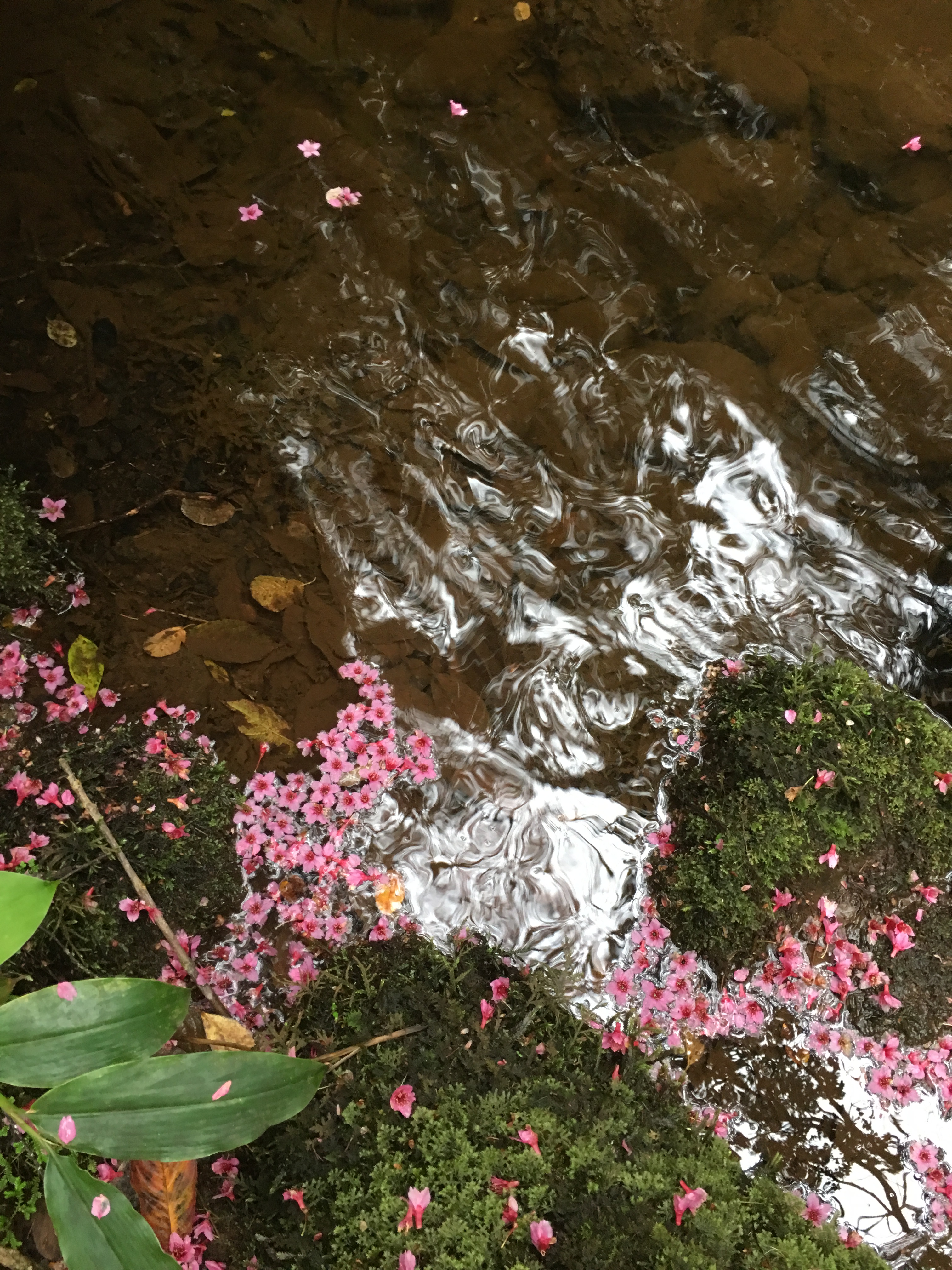
I recently took a class called Introduction to Rosc Poetry through the Irish Pagan School. It’s taught by Irish poet, Geraldine Moorkens Byrne and it is highly informative and inspiring.
The rosc is an ancient poetry form, magical, often political, sometimes prophetic. The Morrigan’s Prophecies are examples as are Amergin’s famous invocations of Ireland.
Here’s my homework. As readers of this blog are likely to know I am an ally of the Protectors of the sacred mountain Maunakea and the efforts to keep it free of a proposed observatory project called TMT (Thirty Meter Telescope).

False Tower
A false tower not built
the TMT, 18 story observatory
–like at Dowth
in darkness remain
only a plan, a bad plan
a troubling dream
vapors vanish in morning breeze
mammoth mountain rising from depths of sea
Maunakea
umbilicus of heaven and earth
red cinder and snow
even in tropic latitude
towering rampart
silver sworded
glacier scarred
summit above this world
you rise
majestic giant
Your Protectors undeterred
a great host
anchored in truth and ritual
victorious under sun and southern cross
highest mountain defeats
the Thirty Meter Telescope.
—Bressal’s* tower the spell was broken
Here too, this tower, it is not built
the spell is broken, the desecrators driven
far away over the vast oceans.
*King Bressal was noted in Irish place lore as having attempted to build a tower to reach heaven in the vicinity of Dowth (which means Darkness) with the help of his sister’s spellwork, which made an unending day for the laborers. But the king raped his sister and the spell was broken and the tower not completed. See Anthony Murphy’s Mythical Ireland for insightful elaboration. This king and sister have been in the news lately with the discovery of incest in remains at the Brugh. Perhaps a distant folk memory.
Check out course offerings from the Irish Pagan School here:
Anglo-Saxon Heathenry and Roman Polytheism
Heathen Spirit Worker
poetry, Celtia, mythology
The Inspiration of a Nun of Annwn
The official website of The Koinon
Diasporic Chinese Polytheism
Children of Brighid
A Poet's Life in Italy
Spirit-Work & Devotional Polytheism
Provocative Pagan Philosophy